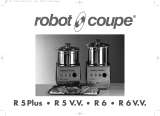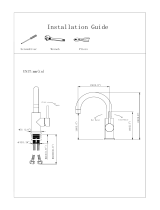22
Complete cleaning procedure, to be performed
regularly based on frequency of use.
- Unplug the power mixer.
- Remove the bell from the foot.
- Disassemble the different parts of the bell, being
careful to avoid damaging the blade shaft
surfaces and cartridge gaskets. Clean each part
with a mild detergent.
- Ensure that all the different parts are thoroughly
dried before reassembly.
- Immerse the foot, detached from the bell, in a mild
detergent solution for one minute. Rinse and let
dry before re-attaching the bell.
• BLADES
The blades can be removed from the bell for
thorough cleaning.
Always dry the blades thoroughly after cleaning to
avoid spotting.
• WHISK HOLDER
Never immerse the whisk holder in water. Clean it
with a slightly damp cloth or sponge.
Never clean the whisk holder in a dishwasher.
• WHISKS
The whisks can be cleaned either by hand or in a
dishwasher.
To ensure effective cleaning, we advice you to
remove the whisk ejector.
MAINTENANCE
• BLADES
The performance of the cut essentially depends
on the state of your blades and their wear. The
blades are subject to wear and as such need to be
replaced from time to time to ensure the consistent
quality of the end product.
You are also advised to change, at the same time,
the washer and the watertight seals.
• WHISKS
The success of your preparation will depend
essentially on the state of the metal wires and their
amount of wear and tear. They should therefore
be replaced from time to time in order to ensure
optimum quality of the finished product.
• FOOT SEAL
In order to maintain a perfect watertight seal between
the foot and the bell it is necessary to check the wear
of the seal regularly and replace it if necessary.
• WASHER
The washer can be greased using a suitable food
safe lubricant.
In order to maintain a perfect watertightness it is
necessary to check the wear of the washer, and if
necessary, to replace it.
After using the power mixer in a hot preparation,
cool the bottom of the foot in cold water before
dismantling the bell from the foot.
After completion of preparation, clean immediately
to prevent food from sticking to surfaces.
• MOTOR UNIT
Never put the motor unit and its handle in water,
clean them with a damp cloth or a sponge.
• FOOT AND BELL
It is possible to proceed in two ways:
• Simple cleaning procedure
- Place the foot and bell into a suitable container
with water and switch on for a few seconds to
clean the bell and the foot.
- After unplugging the appliance - essential -,
making sure that no water finds its way into the
foot, detach the bell from the foot to avoid a
build-up of condensation.
IMPORTANT
Check that your detergent is suitable for
cleaning plastic parts. Some washing agents
are too alkaline (e.g. high levels of caustic
soda or ammonia) and totally incompatible
with certain types of plastic, causing them to
deteriorate rapidly.
WARNING
From time to time, check:
- The state of the 3 buttons’ watertight
membranes. Even the tiniest cracks will allow
liquid to seep in.
- The state of the blender housing. This, should
not show any signs of cracking or any
abnormal openings which could allow access
to the live components.
WARNING
The inside of the bell must not contain any
liquid or food matter besides condensation.
If any liquid or food matter should get inside
the bell, you must:
- Change the ring / blade assembly
(Ref. 89054),
- Clean and disinfect the bell and the end of
the foot to avoid all risk of contamination.
After each use:
- It is important to detach the bell to eliminate
any condensation and ensure no food matter
has seeped inside. To eliminate condensation,
simply leave the bell detached until it dries.
- When cleaning the bell and the end of the
foot, we recommend using a mild detergent.




























